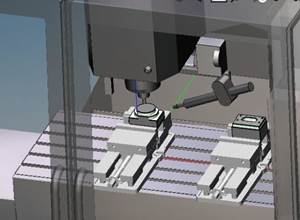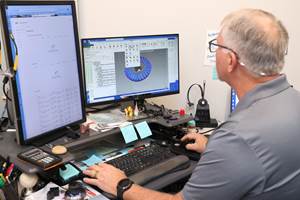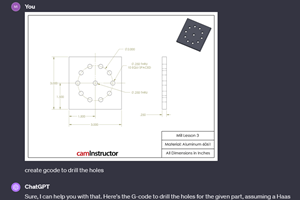A Big Picture Look at Simulation
Utley's Inc. Co. needed a robust solution to verify machining programs for stringent quality and scheduling requirements. Implementing NCSIMUL Machine from Spring Technologies helped reduce crashes and increase tool longevity.
Share






Manufacturing mistakes and machine tool crashes are expensive. In addition to the material cost of a scrapped part, companies have to consider the value of lost time. To ensure this is not the case when creating packaging models for consumer product companies, New York City prototype production company uses NCSIMUL Machine software from Spring Technologies of Boston, Massachusetts, to verify machining programs and ensure the models it provides fulfill stringent quality and scheduling requirements.
Utley’s is a full-service prototype and custom modeling house located in Queens, New York. Founded in 1945 by the late George D. Utley II in the basement of his mother’s house, the third-generation, family-run company is now a 40-person team working in a 16,000-square-foot facility. The business combines machining processes, like high-speed multi-axis machining and additive rapid prototyping, with RTV molding and casting, assembly and fabrication, and handcrafting techniques to deliver packaging prototypes and custom models for clients in the cosmetics, liquor and other industries.
Quality and speed are of the utmost importance for Utley’s. Sample products must meet customer standards for accuracy and aesthetics as well as fast development timeframes for approvals and market testing. A mistake in the machining of a model costs both time and money. Utley’s CNC programmer Antonios Karoustos says that producing a prototype also includes investment in the time spent performing operations other than machining. For example, damage to a part that already has 40 hours of machine and other labor time on it can require restarting the production process with consequent loss of time and disruption of delivery schedules.
Mr. Karoustos says problems can arise when a large number of tool paths and machine movements are brought together in the final machining operation. For example, on a large, complex model, a tool can successfully machine a complex feature, but a subsequent table rotation might cause the tool to gouge the part. While machining a pocket, a tool might not retract high enough, causing it to cut through the wall when the machine table moves or when the tool is changed. Incorporating a large number of programmed tool and machine moves into one large CNC program can overwhelm the verification features of a standard CAM package, Mr. Karoustos says. The problems may not appear when tool paths are analyzed individually, and in some cases the verification will indicate no problems. However, when the part is actually run, unforeseen issues can occur.
To minimize this risk, Utley’s uses NCSIMUL Machine software, a component of NCSIMUL Solutions unified machining process software platform, to simulate, verify, optimize and review its CNC machining programs. The simulation software’s 3D graphics are designed to help eliminate machining crashes, while embedded algorithms and process-based know-how are said to enable optimization of cutting conditions and standardization of shopfloor documentation. The software verifies NC programs in three steps: It investigates and corrects coding errors, simulates machining to locate collisions and repair motion errors, and validates the NC program.
Mr. Karoustos says NCSIMUL enables Utley’s to seamlessly import tools and workpiece stock from a CAM program and integrate a number of separate tool paths and machine movement commands into one master NC program, revealing potential problems. It consolidates many operations into one large program and presents it as if it was running in the machine, he says. The software runs through the code and visually highlights issues in red on the part in the display. It’s not just looking at the code itself; it’s also looking at the actual tools. For example, it makes sure the tool length is appropriate for the task, he says.
NCSIMUL interfaces directly with CAM packages, specifically the Mastercam software Utley’s uses 80 percent of the time. The operator is only required to specify the tools and the program, which are then automatically brought into NCSIMUL. “You don’t have to go and fiddle around and create new tools or create your stock,” Mr. Karoustos says. “Being able to import everything so seamlessly is a big advantage.”
The software stores programs individually and represents them with screenshots that facilitate documentation and updates. NCSIMUL also provides dimensioning data that can be used for quality control or inspection.
NCSIMUL’s crash-avoidance technology can also help ensure machine tool longevity. Utley’s currently operates two Hurco CNC and three Haas CNC mills, and is installing a new 20,000-rpm Okuma CNC machine with a rotary table. “We’re making some pretty key investments in our CNC department to help us get our parts out to our customers as fast as possible,” Mr. Karoustos says. “We are planning to do a lot of work on the Okuma and will have NCSIMUL test any programs for the new machine, because it is very expensive and we want to avoid damaging it. We’re going to make sure that we run everything through NCSIMUL.”
Presently, Utley’s machine tools run in four-axis mode, but the company is in the planning stages of using five-axis techniques. “Obviously when we do that, we’re going to go back to NCSIMUL for a simulator,” Mr. Karoustos says.
Overall, he says the company is happy with the software. “We’ve really had a lot of luck with it. We haven’t crashed anything in a very long time, and we’re grateful for that. To us that is the big litmus test.”
Related Content
How Integrated CAD/CAM Transforms Inventions Into Products
The close connection between CAD and CAM is what links creative ideas to practical production for this unique custom manufacturer.
Read MoreTTI Brings Specialty Gear Production In-House with Multiaxis Machining
By investing in a 3+2-axis machine and utilizing simulation software for diagnostic checks, Techtronic Industries turned a four- to ten-week lead time into a one- to two-week lead time.
Read MoreCan ChatGPT Create Usable G-Code Programs?
Since its debut in late 2022, ChatGPT has been used in many situations, from writing stories to writing code, including G-code. But is it useful to shops? We asked a CAM expert for his thoughts.
Read MoreTurning the Corner on Virtual Machining and Simulation
Simulation software’s effectiveness comes down to proper implementation and alignment with shop priorities.
Read MoreRead Next
Last Chance! 2025 Top Shops Benchmarking Survey Still Open Through April 30
Don’t miss out! 91ÊÓƵÍøÕ¾ÎÛ's Top Shops Benchmarking Survey is still open — but not for long. This is your last chance to a receive free, customized benchmarking report that includes actionable feedback across several shopfloor and business metrics.
Read MoreAMRs Are Moving Into Manufacturing: 4 Considerations for Implementation
AMRs can provide a flexible, easy-to-use automation platform so long as manufacturers choose a suitable task and prepare their facilities.
Read MoreMachine Shop MBA
Making Chips and 91ÊÓƵÍøÕ¾ÎÛ are teaming up for a new podcast series called Machine Shop MBA—designed to help manufacturers measure their success against the industry’s best. Through the lens of the Top Shops benchmarking program, the series explores the KPIs that set high-performing shops apart, from machine utilization and first-pass yield to employee engagement and revenue per employee.
Read More






















